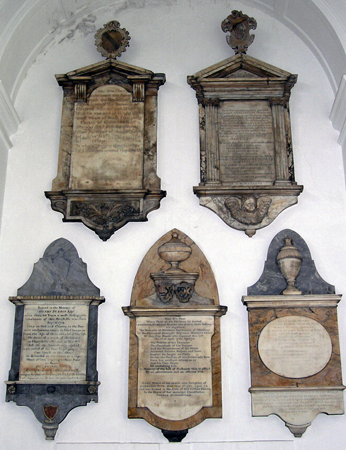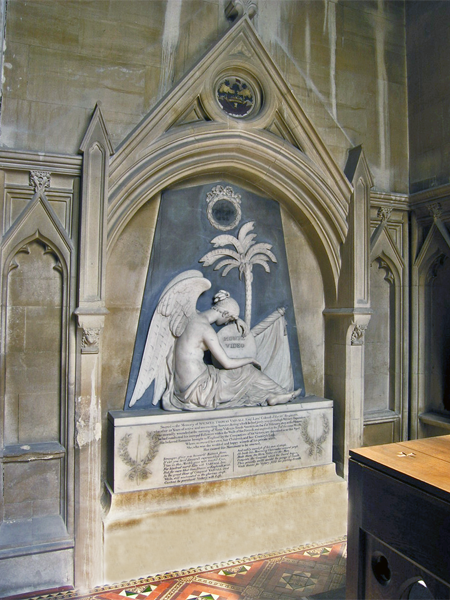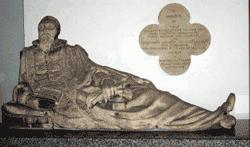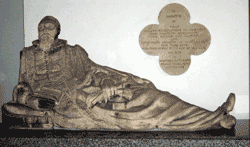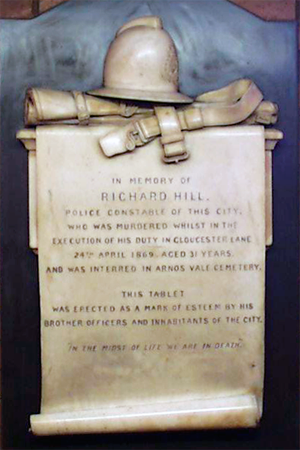 |
BRISTOL |
 |
| With Bristol I depart from Pevsner's organization which included Bristol in one of his Somerset volumes. Local government and boundary changes are not the most thrilling of subjects so here I will just say that Bristol used to be 'in' both Somerset and Gloucestershire until 1974 when it became part of the new county of Avon which also included bits from adjacent counties. In 1996 Avon was abolished, some bits were shed and Bristol became a county in its own right as well as a city. In fact Bristol was once before a county for a while: it was granted that status by King Edward III in 1375. It will probably change again in the future but here it stays in these pages. |
St Mary Redcliffe St. Michael, St Michael's Hill St Nicholas, High Street St Paul, Portland Square St Phillip & St Jacob, Narrow Plain St Stephen's, St Stephen's Avenue St Thomas, Thomas Lane
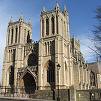 |
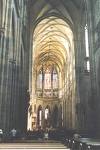 |
The
Cathedral Cathedral Church of the Holy & Undivided Trinity (originally Abbey of St Augustine) |
 |
 |
| (no entrance fee; no charge for photography
but contributions always welcome please!) (A very friendly cathedral but easy to set off alarms!) |
| Note: Bristol Cathedral is a Cathedral of the New Foundation, that is, one of the several cathedrals that was founded - or refounded - by Henry VIII at the time of the Reformation. Before then the church was not a cathedral at all (so not the seat of a bishop) but rather an Augustinian Abbey, that is, a monastery of Canons Regular - priests who lived under the rule of St Augustine and who were presided over by an Abbot. The see was founded in 1542: a bishop was installed (see below) and the cathedral itself administered by a Dean and Chapter of Secular Canons - priests not living under a monastic rule - which is more or less the situation today. This explains some of the monuments found both here and at Wells. I surveyed the monuments Bristol as part of Dr Clive Easter's symposium in the city. |
| Cloisters Eastern Lady Chapel Elder Lady Chapel Nave and Aisles Newton Chapel North Chancel Aisle North Transept South Transept South Chancel Aisle |
| Eastern Lady Chapel |
 |
 |
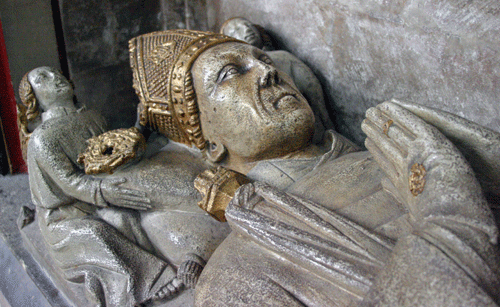 |
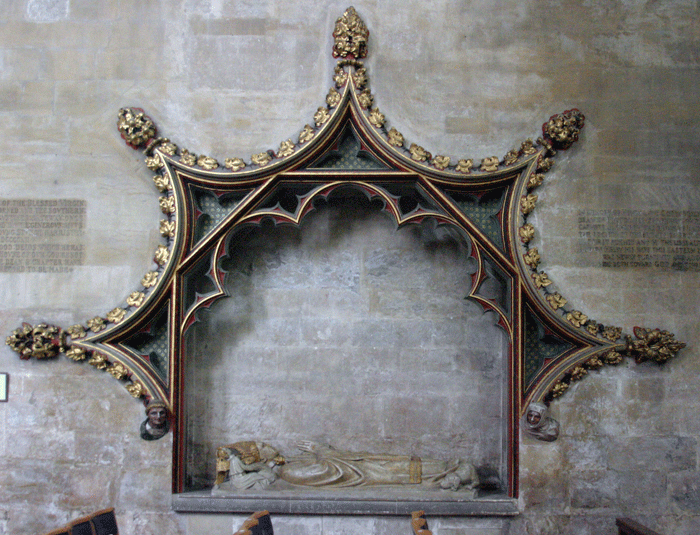 |
| Abbot Hunt (1481) Abbot 1473-1481 |
 |
 |
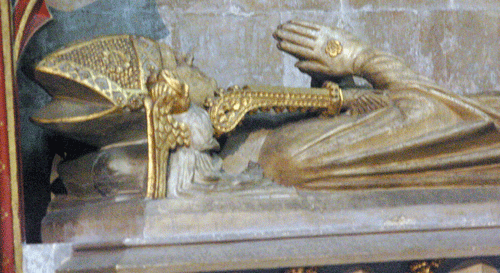 |
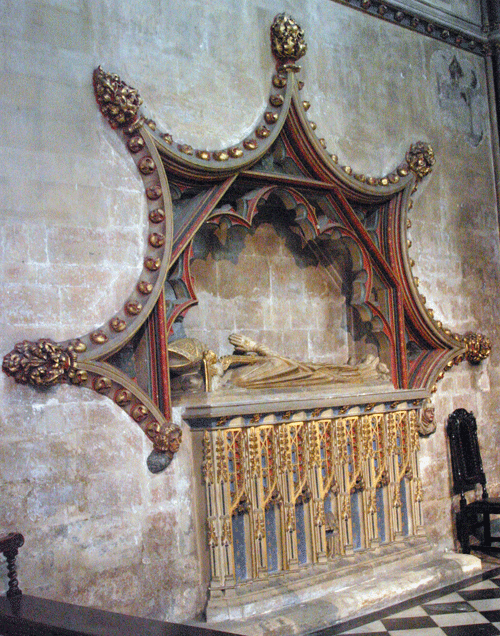 |
| Abbot Newberry (1473) Abbot 1428-1473 |
 |
 |
 |
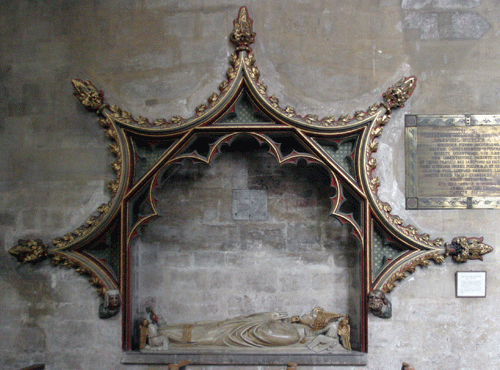 |
| Abbot Newland (1515) Abbot 1481-1515 |
| North Chancel Aisle |
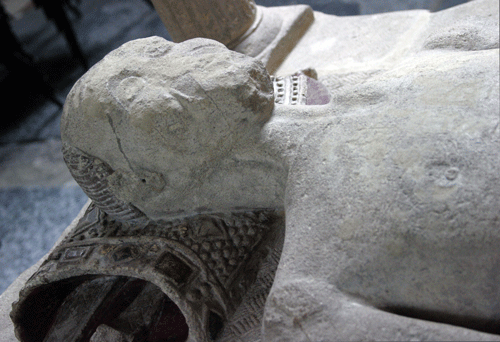 |
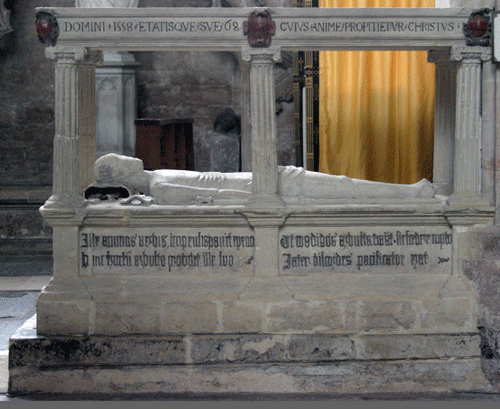 Bishop Paul Bush (1558) He was concecrated as the First Bishop of Bristol in 1542 but deprived by royal decree ofMary Tudor in 1554 for being married. He retired to the Rectory of Winterbourne, where some sources say he is buried. However most state that he and his wife were buried in the Cathedral. Cadaver effigy only. |
 |
 |
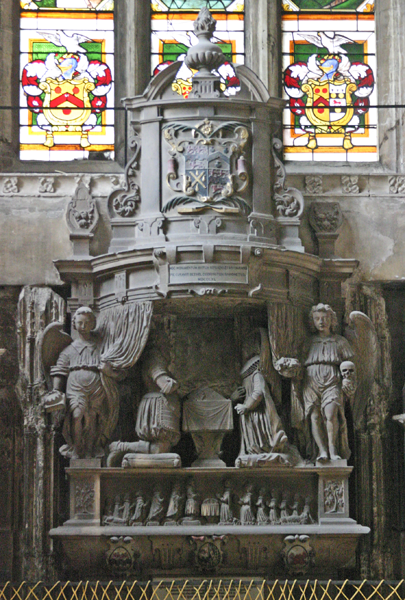 |
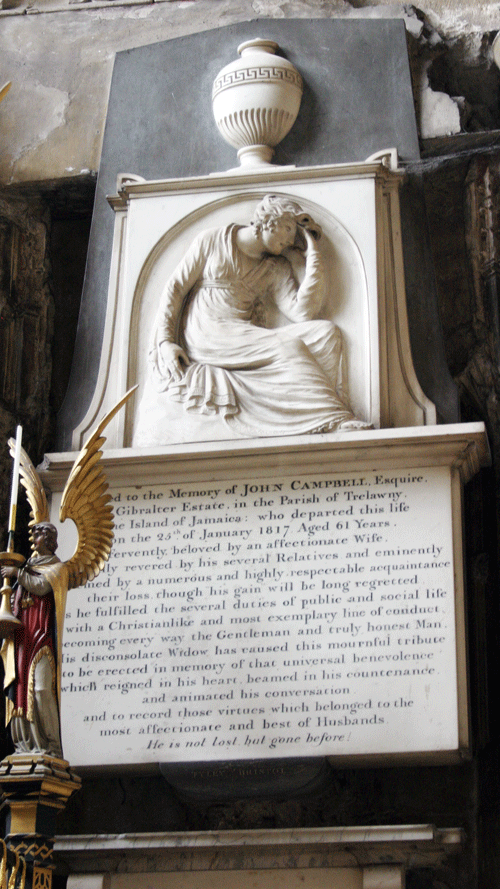 |
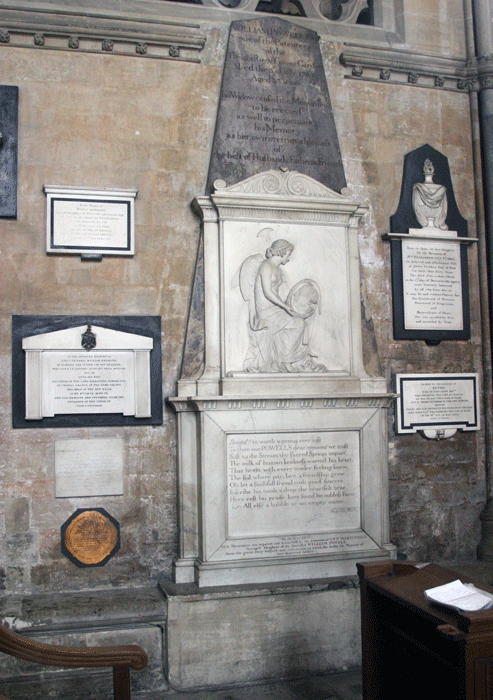 |
|
Robert Southey
(1843) The poet; a Bristol man. Buried Crosthwaite, Cumbria Portrait Bust by Baily |
Robert Codrington
(1618)
and his wife, Anne Figures kneel at a prayer desk flanked by angels. The children - Christopher, Robert, John, Florence, Nicholas and nine others - kneel similarly below |
John Campbell (1817) by Jabez Tyler |
William Powell
(1769) By J Paine A seated Genius holds a portrait medallion. Several smaller wall monuments can be seen: there are many in most parts of the Cathedral, especially the cloisters, which have not been included in this survey. |
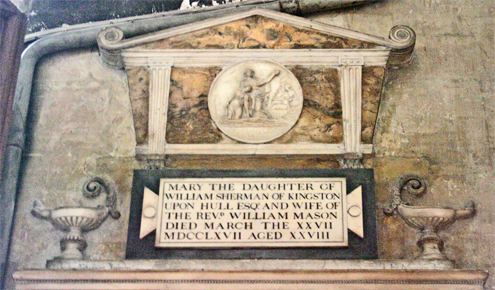 |
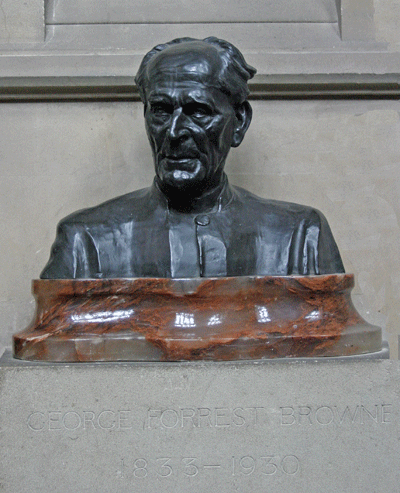 |
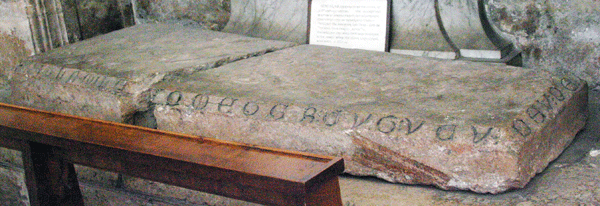 |
Above Left:Mary Mason
(1767) Medallion with figures on sarcophagus
By John Bacon Above Right: George Forrest Browne (1833-1930) 48th Bishop 1897-1914 Bronze bust Left: 'William the Surveyor' Coffin lid (not in situ) with foliated cross and inscription written in Lombardic characters and in Norman French: William the Surveyor lies here - God on his soul have mercy. Amen. He may have been surveyor when the Elder Lady Chapel was built, c. 1220 |
| North Transept |
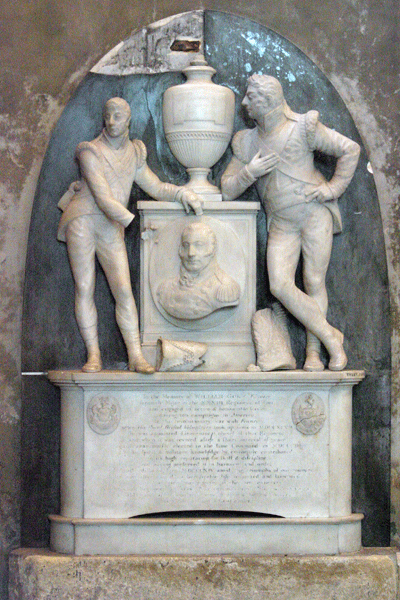 Above: Major W. Gore (1814) By Tyler Right Top: Peter Maze (1849) A Bristol Merchant Right Bottom: Abbot David (1216-1234) Tomb slab with head above a cross, both carved in low relief: one of the arms of the cross can just be made out. Very worn. |
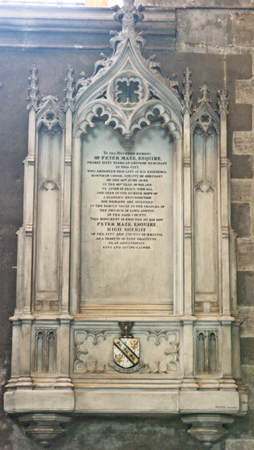 |
 |
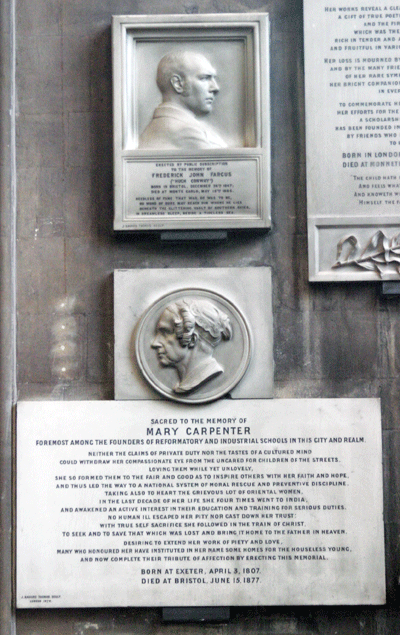 Above top: Frederick John Fargus 'Hugh Conway'(1885) Bottom: Mary Carpenter (1877) Both signed by Havard Thomas Left Above: Bishop Joseph Butler DCL (1752) |
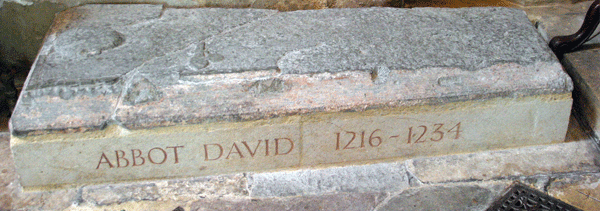 |
|||
| Elder Lady Chapel (Accessible from the North Transept) |
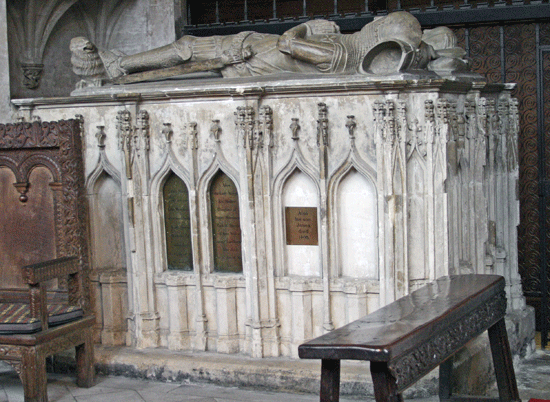 |
 |
| Maurice 9th Lord Berkeley (1368) & his Mother Margaret
(1st Wife of Thomas) This monument lies between the Elder Lady Chapel and the North Transept but is best seen from the latter. Note the armour detail. Arms are carved on the 'jupon' |
|
 |
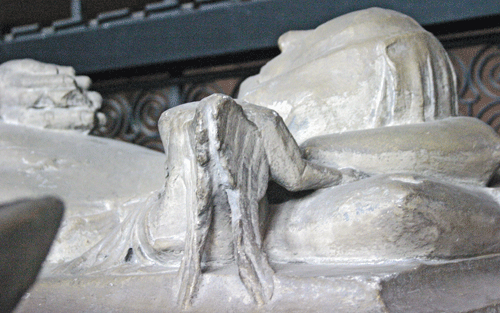 |
| South Transept |
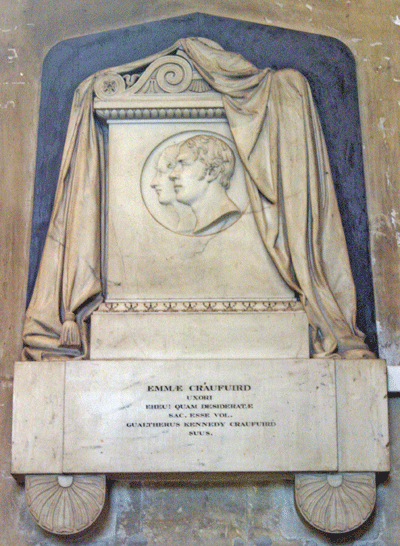 |
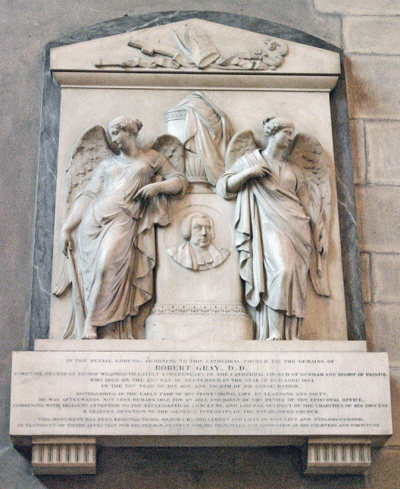 |
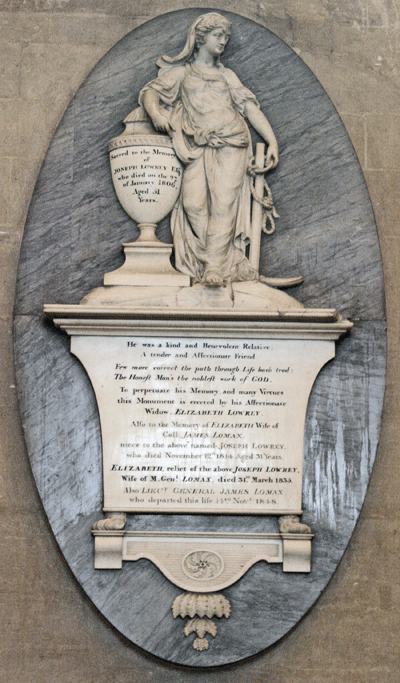 |
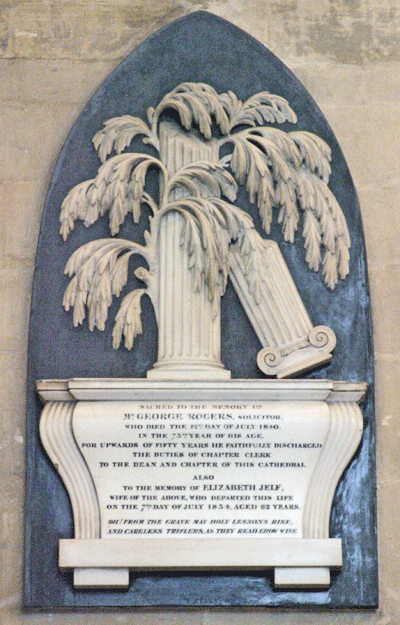 |
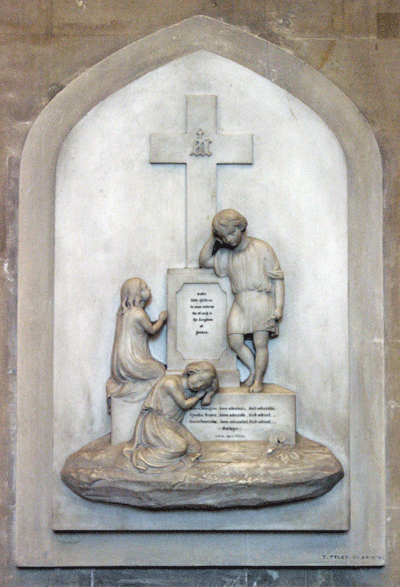 |
| Emma Craufuird (1823) By Sir Charles Chantry |
Bishop Dr Robert Gray (1834) By Baily |
Joseph Lowrey (1806) | George Rogers (1840) Solicitor & for 50 years Chapter Clerk |
Laura Josephine
(1839-1843)
Charles Roper (1845-185-) Laura Henrietta (1857-185-) Malwyn By T. Tyler, Bristol |
| Newton Chapel - (accessible from the South Transept) |
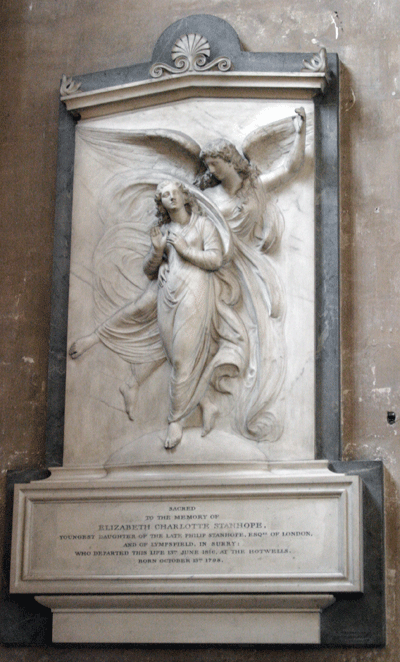 |
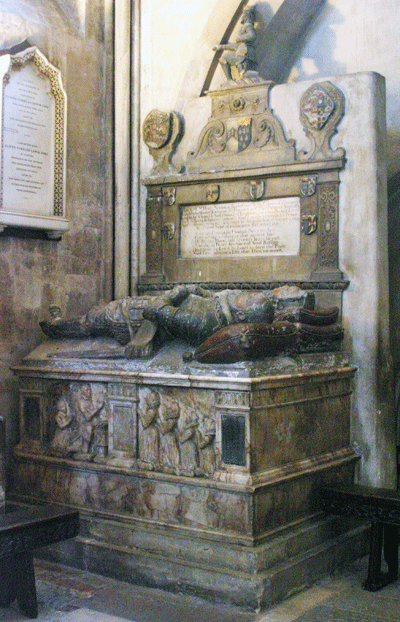 |
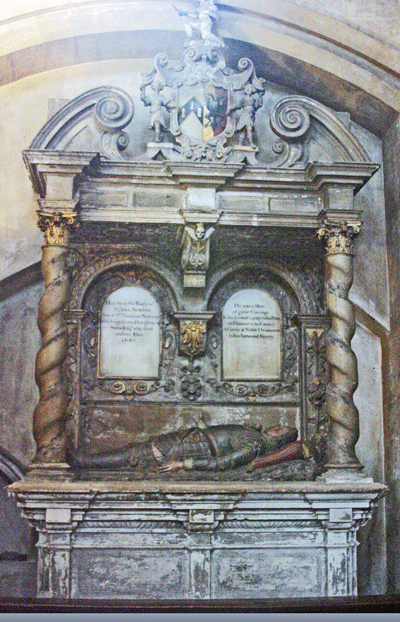 |
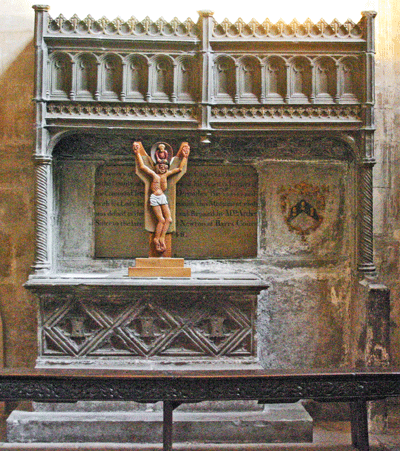 |
| Ekizabeth Charlotte Stanhope (1816) By Westmacott |
Sir Henry Newton (1599) and his wife, Catherine. The children kneeling below are: Theodore, Elizabeth, Margaret and Anne | Sir John Newton (1661) | Unknown. Probably 15th century |
| Sir Jonathan Trelawny Bt (1721) |
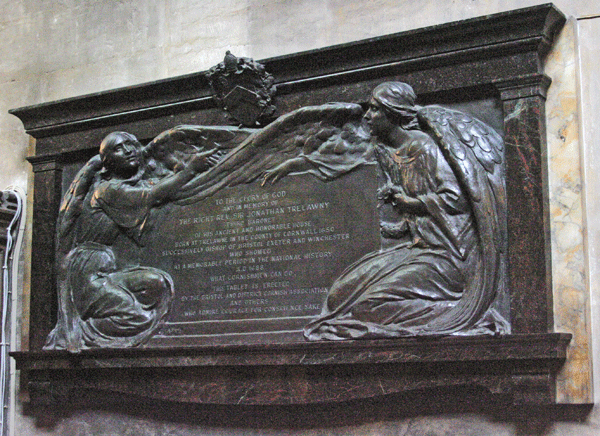 Sir Jonathan Trelawny was elected Bishop of
Bristol and became one of Seven
Bishops tried for seditious libel under
James II for protesting against the
Declaration of Indulgence,
which granted religious toleration to Roman Catholics. In fact,
it appeared to grant religious freedom of worship to all
denominations but it was felt that the King had an
hidden agenda and the declaration could be changed by the
King's sole authority. Sir Jonathan Trelawny was elected Bishop of
Bristol and became one of Seven
Bishops tried for seditious libel under
James II for protesting against the
Declaration of Indulgence,
which granted religious toleration to Roman Catholics. In fact,
it appeared to grant religious freedom of worship to all
denominations but it was felt that the King had an
hidden agenda and the declaration could be changed by the
King's sole authority.The bishops declared that, while they were loyal to King James, they were protesting against the declaration on a matter of conscience. They were held for seven weeks, tried and acquitted to much rejoicing. After James II's military defeat Sir Jonathan was awarded the Bishopric of Exeter. His later appointment to Winchester was also controversial as Queen Anne, wishing to keep ecclesiastical appointments as her prerogative overruled her minister and the Archbishop of Canterbury. The promoted the 'Bishops' Crisis'. He was buried at his birthplace Pelynt, Cornwall. He is remembered in the song Song of the Western Men by the lines 'Shall Trelawney die'. However this is more likely to refer to his grandfather, Sir John Trelawny who was imprisoned by parliament for electoral irregularities. The Cornish never marched on behalf of whichever Trelawny it was as suggested in the song. Bronze by Alfred Drury |
| South Chancel Aisle |
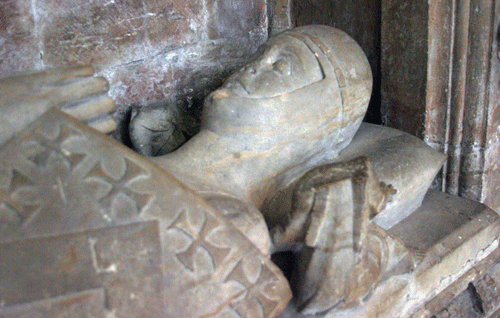 |
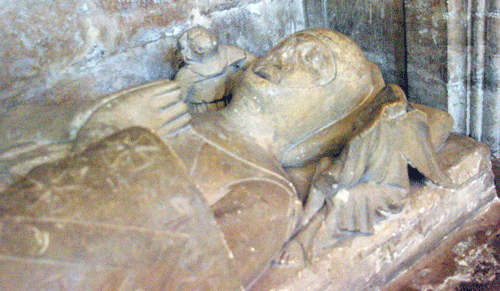 |
 |
 |
Maurice II, Lord Berkeley (1281) Note that this effigy has straight legs and the carved heraldry on the shield. Designation is unconfirmed. |
Thomas, Lord Berkeley (1321)
Note that in contrast that this effigy
has crossed legs but it also has carved heraldry. He
fought at the battles of Evesham and of Bannockburn. Again the designation is unconfirmed |
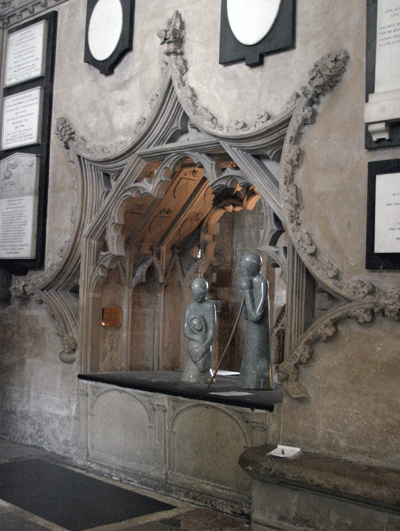 |
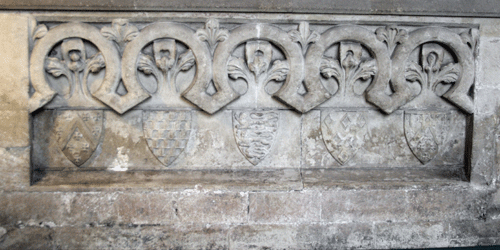 |
 |
 |
| Left: Thomas, Lord Berkeley (1321) & Joan
(1309), view from the south chancel aisle,
and, above, view of the same monument from Berkeley Chapel, which is accessible from this aisle. Right: Harriet Isabella (1826) & John Middleton By Edward Baily Far right top: William Brame Elwyn (1841) by Edward Baily. And below this monument, Mary Brame Elwyn (1818) |
 |
| Nave and Aisles |
 Left column: Dean Gilbert Elliot (1891) He was Dean 1850-91. The effigy is by James Nesfield Forsyth The monuments of the two deans are in niches in at the east of the North & South Aisles respectively. Right column: Dean Francis Pigou (1916) He was Dean 1891-1916, succeeding Dean Elliot. The effigy is by N A Tren |
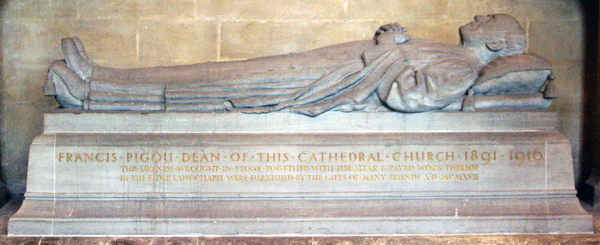 |
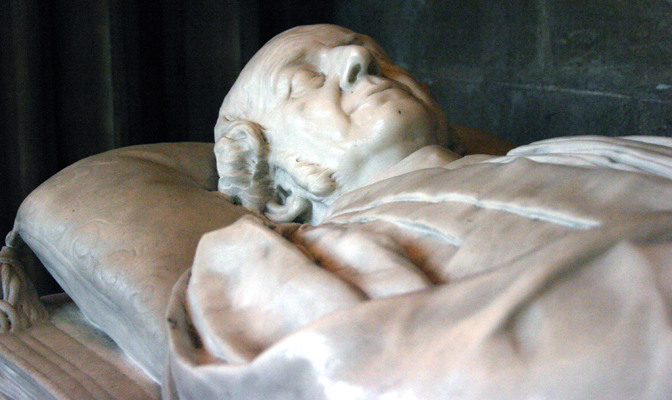 |
 |
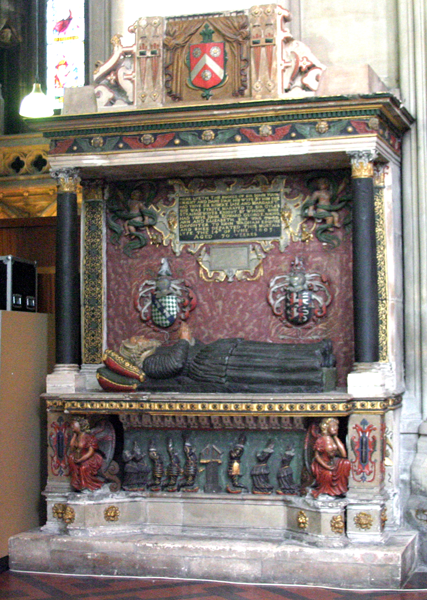 |
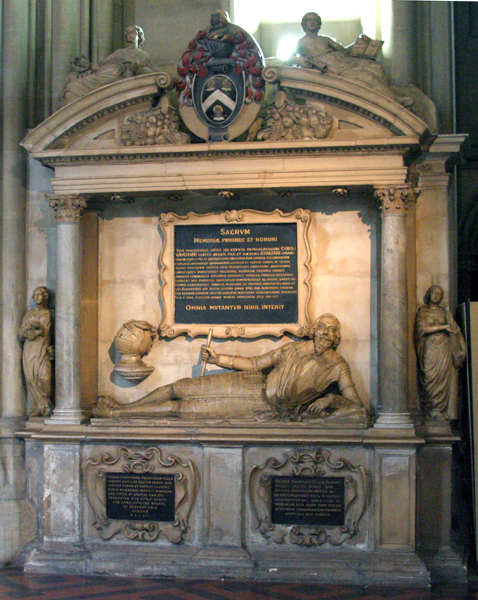 |
| Dame Joan (1603) & Sir John Young By Samuel Baldwinn. | Sir Charles Vaughan (1630) |
| These two monuments monument are to the North and South of the West Door. They were originally elsewhere but moved to the present position when the nave was completed at the end of the 19th century. | |
| The Cloisters |
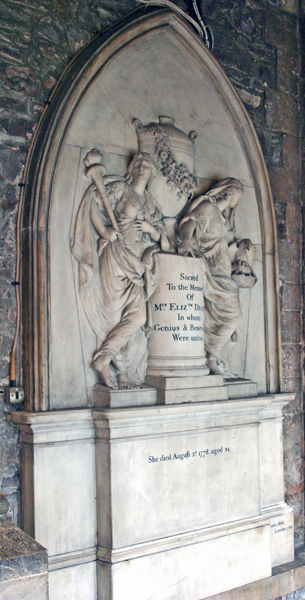 Elizabeth Draper By John Bacon (signed 'J Bacon fecit London 1780') |
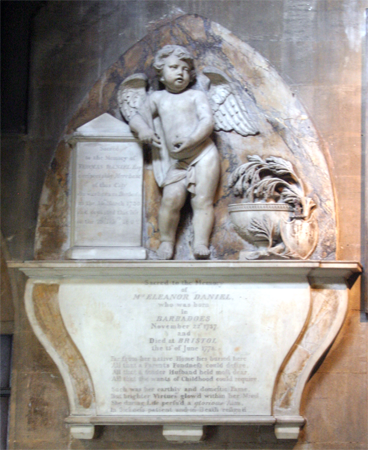 Eleanor Daniel (1774) |
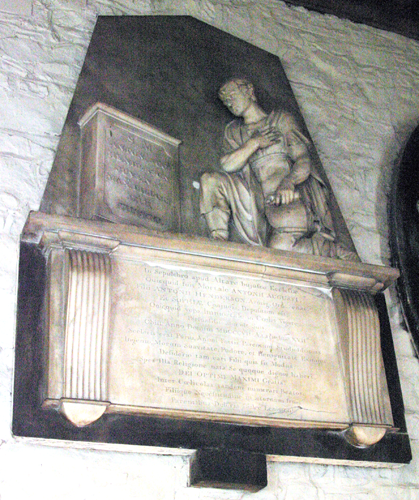 A A Henderson (1807) |
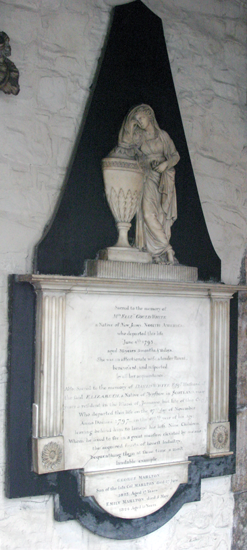 Elizabeth Gouldwhite (1793) |
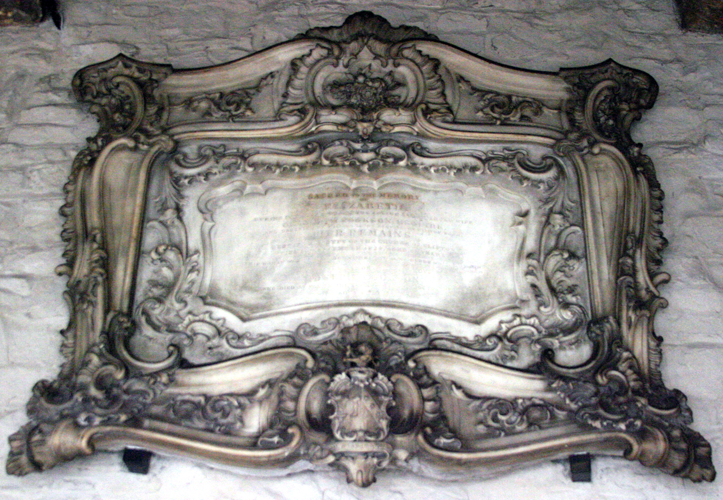 Elizabeth Cookson (1852) |
|||
.jpg) |
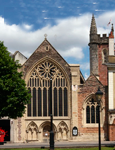 |
St Mark's or The
Lord Mayor's Chapel (Opposite the Cathedral) |
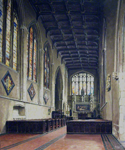 |
| At the time of writing the chapel is closed
to visitors to allow installation of new fire safety system; it
is planned that it is to open again on 10th April 2020. However
please check with the verger on this e-mail
Marek.Barden@bristol.gov.uk Visit the chapel's website - https://lordmayorschapel.org/ - for further information |
| St Mark's, Bristol, also known as The Lord
Mayor's Chapel, is a peculiar, this is a, church not subject to
the jurisdiction of the diocese
jurisdiction in which it is situated. Such churches are
now uncommon: they include Westminster Abbey and the Temple
Church, London. St Marks was once a chapel to a hospital , a
religious foundation, which was dissolved by Henry VIII;
the chapel was then sold to the City Council who still own and
administer it. The hospital itself was refounded as The Queen
Elizabeth's School. The relationship of the
chapel with the diocese makes fascinating history. The church is peculiar in yet another way: it is orientated north-south, rather than the in the usual east-west layout, where the altar is at the east end of the church. However for clarity (church crawlers assume the altar is at the east and do not normally consult a compass!) the information below is written as if the church were orientated in the usual manner. |
| The Nave |
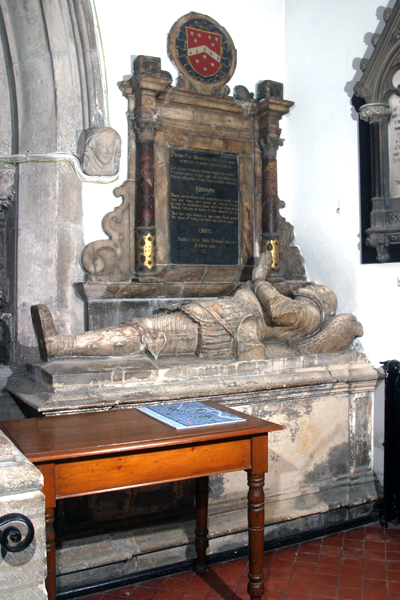 |
 |
 |
 |
||
| Sir Richard Berkeley (1602) Ward of Henry VIII, Lieutenant of Tower, High Sheriff & Deputy Lt of Gloucestershire. Alabaster. (S Wall - W End) |
William Birdie (1590) Mayor of Bristol, Benefactor of Queen Elizabeth's Hospital. Note the Sword of State below the epitaph. (N Wall - W End) |
|
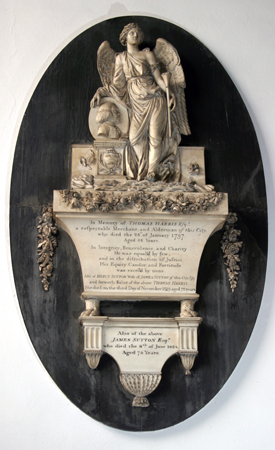 |
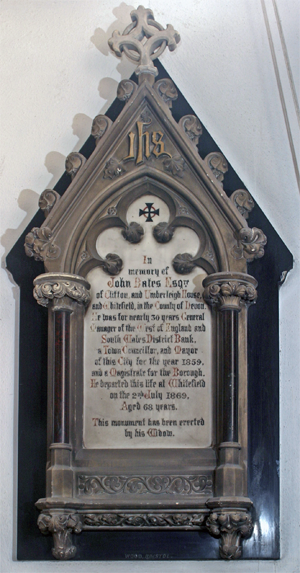  |
 |
| Thomas Harris (1797) He was merchant and alderman of Bristol. The monument also commemorates Mercy (1819), his widow, who later married James Sutton. Below is added the aforementioned James Sutton (1824) (N Wall) |
Top: John Bates
(1869)
Local bank manager, city councillor & Mayor in 1859 Botttom:Revd John Hakesworth LLD (1866) Head Master of Queen Elizabeth's Hospital. Signed: Wood Bristol |
Top:
George
Adderly (1786) &
his daughter
Charlotte (1775 aged 15 ); both
are buried in a vault
below the monument. Bottom: James Gibbs JP (1855) ; he was Mayor in 1842. |
| The Chancel |
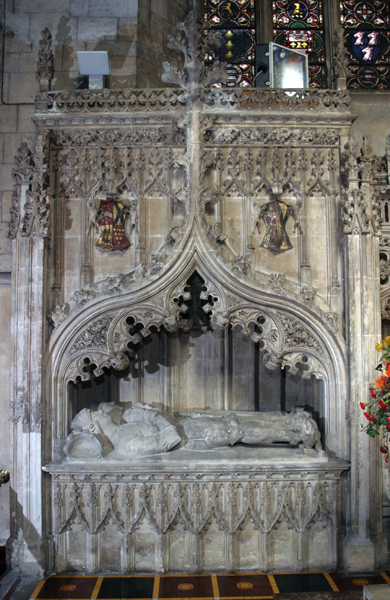 |
 |
 |
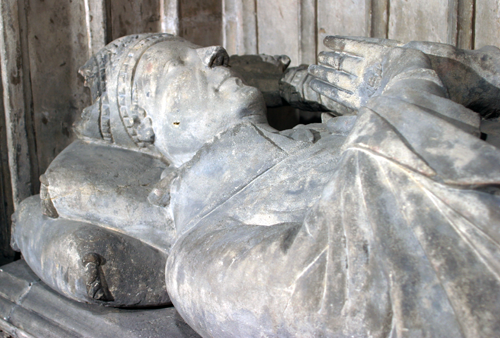 |
 |
 |
| Above left columns and
centre column top:
Sir Maurice (1464) & Lady Ellen Berkeley. Above rights columns and centre column bottom: Bishop Miles (or Milo) Salley (1516) of Landaff. (Both of the above monuments are on North Wall.)  |
|
| South Aisle |
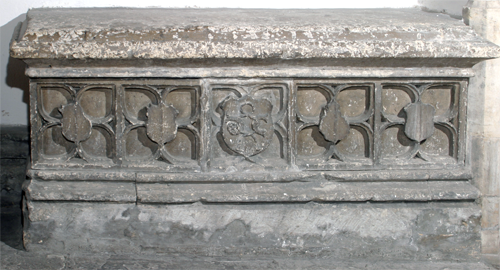 |
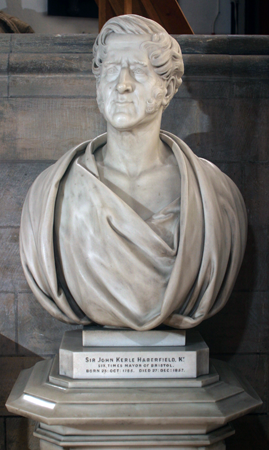 |
 |
|
Above: Tomb Chest (said to be that of John Carr, Founder of Queen Elizabeth's Hospital) (N Wall) Right: Sir John Kerle Haberfield Kt (1857) Six time mayor of the city. By Tyley. (South wall - west end) |
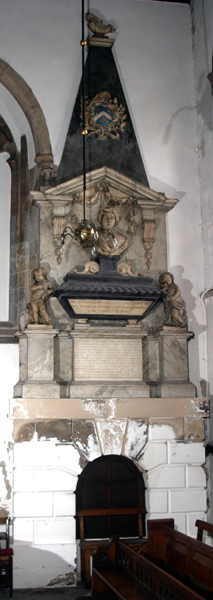 |
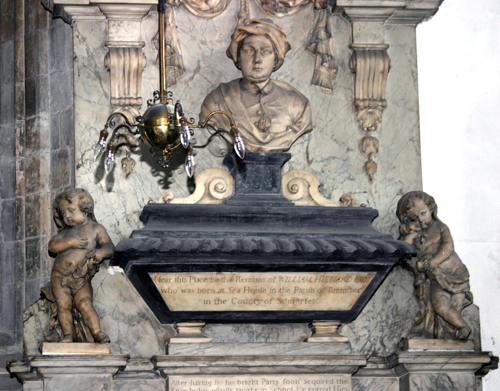 |
 |
 |
||
Left and above top: William Halliard (1735) By Thomas Parry. (South Wall) Right and above bottom:: An unknown merchant (c 1360) but the tomb chest is 15th Century. (S Wall) See also below |
 |
_Civilian-3.png) |
 |
 |
 |
| Henry Bengough (1818)
Alderman and founder of
almhouses which carry his name. By: Chantry (West Wall) |
John Cookin (1627, age 11) (South. Wall) | Thomas James (1619) MP, Alderman, Sheriff of Bristol in 1591, Mayor in 1605 & 1614 (West End - North Wall) |
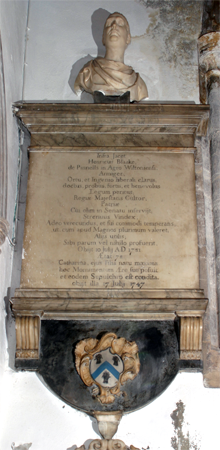 |
 |
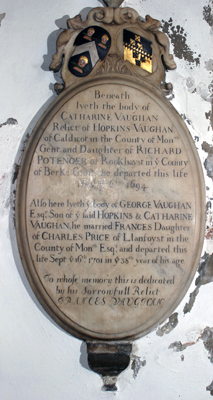 |
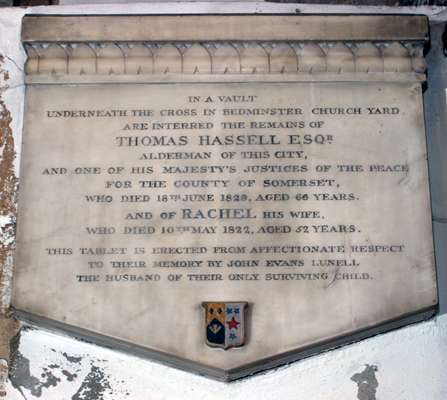 All of the monuments in this row are on the south wall except that of Henry Walter , which is on the north wall |
 |
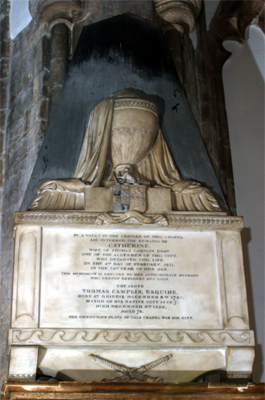 |
| 'Infra Iacet' Henry Blaake (1731) | 'Near this place lyeth' Henry Walter (1727) Mayor & Alderman and his wife Mary (1742) | 'Beneath lyeth the body of' Catharine Vaughan (1694) and her son George (1701) | 'Underneath the cross in Bedminster church are interred the remains of' Thomas Hassell (1829) Alderman JP and his wife: Rachel (1822) |
'In a vault near the communion table of
this chapel are deposited the several
remains of ' John Casberd DD (1803) Vicar of StAugustine's in the city and of Tickenham and Portbury His wife Elizabeth (ob 1802) Their daughters Elizabeth Frances (1770 age 1) and Mary Ann (1774 age 9 month) . |
'In a vault in the
chancel of this church lie interred the
reamains of'... Catherine Camplin (1831) and her husband Thomas Camplin (1856) Alderman |
| St Andrew's Chapel |
 |
 |
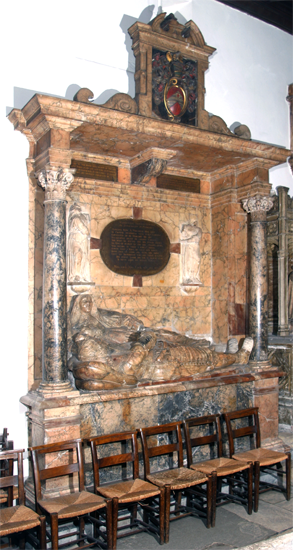 |
 |
||
| Left and centre top:
George Upton (1608) (N. Wall) Right and centre bottom: Sir Baynham (1664) & Lady Throkmorton (1635) Between the couple, who hold hands, is a baby in swaddling clothes who died with the mother. The baby is best seen below centre. (North Wall) |
||
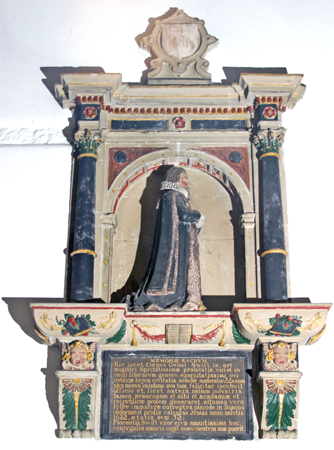 |
 |
 |
| William Swift (1622) (North Wall) | Elizabeth James (1599) (N orth Wall) |
 |
 Dame Mary Baynton (1667) & Two Sons |
 |
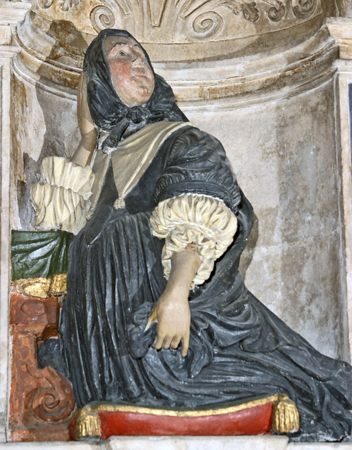 |
 |
 Two Military Effigies (c. 1300) Locally said to be of Maurice de Gaunt (1230) and Robert de Gournay (1269). the co-founders of the hospital and chapel. |
 |
 John Aldworth (1615) and his son, Francis (1623) John was Sheriff of Bristol and a benefactor of Queen Elizabeth's School (North Wall) |
 |
| St James's Priory - Whitson Street |
| In 1984
this C of E church became redundant but was reopened by the
Little Brothers of Nazareth in 1993 as
a RC monastic church. I am unsure if this church allows 'secular' visitors or photography: check by contacting the church via their website. |
|
 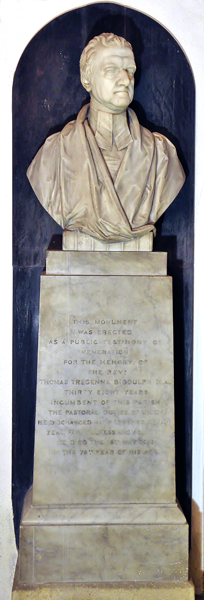 |
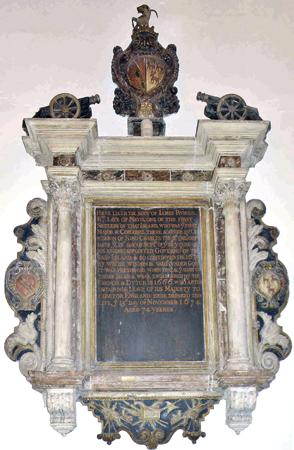 |
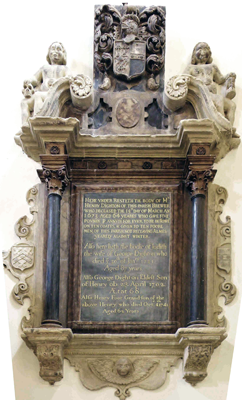 |
 |
| Sir James Russel (1674) 'late of Nevis one of the first settlers of that island' He was later appointed governor | Henry Digton (1673) Brewer. '...who gave five pounds ᵱ annum for ever to be beſosed on ten coates & given to ten poore men of this parish not receaving almes yearely against winter' Also Judith (1721) and her husband George Digton, eldest son of the above. Also Henry Foot (1741), their son | Thomas (1689) & Eliz. Hicks (1694) son and daughter of Thomas Hicks. Also the aforementioned Thomas Hickes (1716) & Martha (1719) |
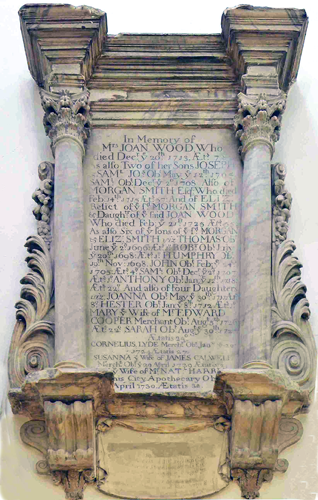 |
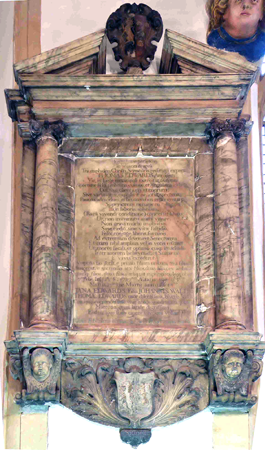 |
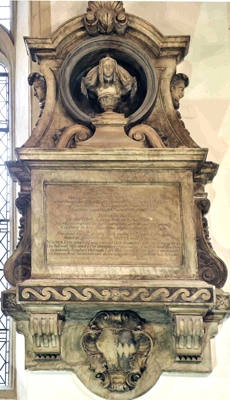 |
| Joan Wood (1713); her two sons Joseph (170_) & Sam.l. (1708). Morgan Smith (1715)& his widow Eliz (1725) daughter of Joan Wood, above. Their six sons: Thomas (1698), Humphry (1698), John (1705), Sam.l. (17__) & Anthony (1718); their four daughters: Joanna (172_), Hester (1712), Mary (Cooper) (172_), Sarah (172_) Also Cornelius Lyde (1721), Susanna 1792) wife of James Calwell, merchant; __ey (1730) wife of Nat.l. Narr___, Merchant | Thomas Edwards (1727) | Mary Edwards (1736), her husband Walter (1758) and his sister Jane (___) |
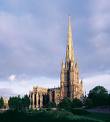 |
Saint Mary Redcliffe |
 |
| Church normally open.
There is no charge for entry or photography (Near Templemedes Station) |
|
|
||||||||||||
| South Transept |
|
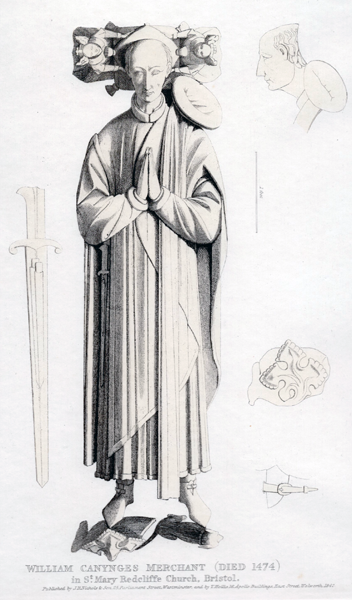 |
||||
 |
 |
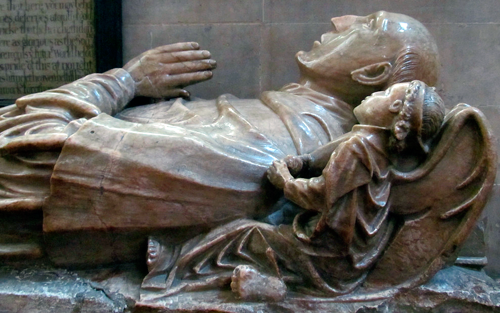 |
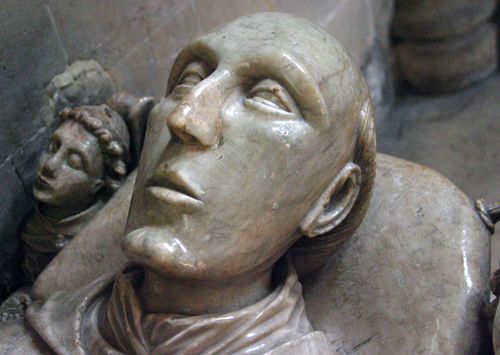 |
 |
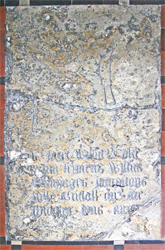 |
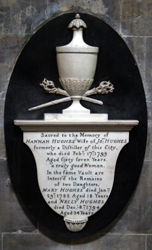 |
|
| Above: Said to be the almoner of William
Canynge. Note the purse and large dog with a big bone;
unusually only a single angel. Right: Unusual grave slab of cook; a knife can be seen of the right and there is a ladle on the left. Inscription. Far right: Hannah Hughes (1799) Wife of a Bristol Distiller |
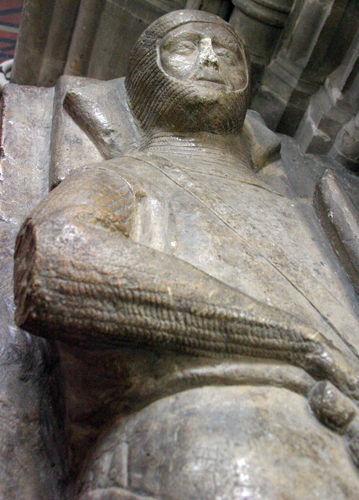 |
North Transept |
 Effigy said to be that of Robert de Berkeley who gave a freshwater spring to the church |
| North Chancel Aisle |
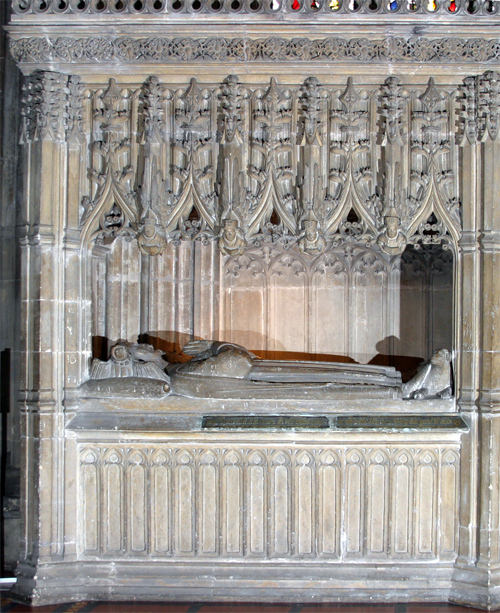 |
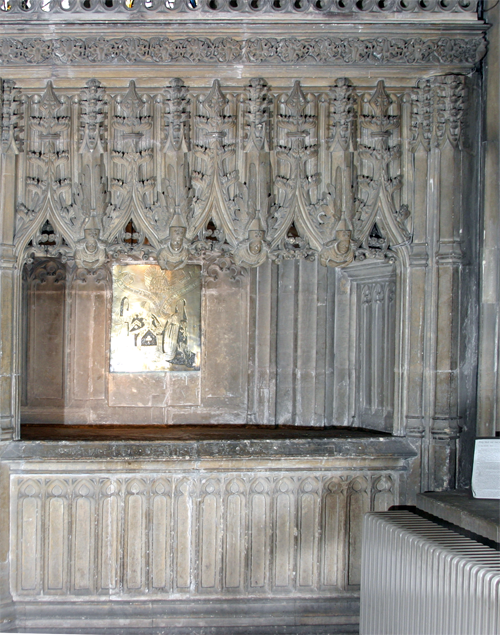 |
 Above: Thomas Mede (1475) and his wife, Margaret. I was unable to satisfactorily photograph the two effigies. Note the fragmentary brass inscription, which states: [Here lies Thomas Mede and his wife, and Philip Mede son of] 'the aforesaid Thomas Mede and thrice mayor of the town of Bristol, died the 20th day of December 1475.' The missing section is written between the square brackets and is deduced. Right and right above: John Mede (1496) and his wife, Alice. There are no effigies but a brass on the back wall, the inscription of which reads: 'Here lies John Mede, burgess of the town of Bristol who died1 7th April 1496 and beside him rests Alice his wife' |
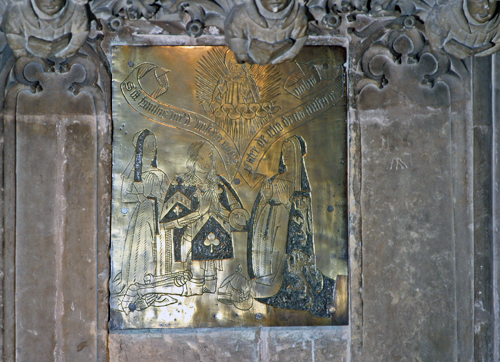 |
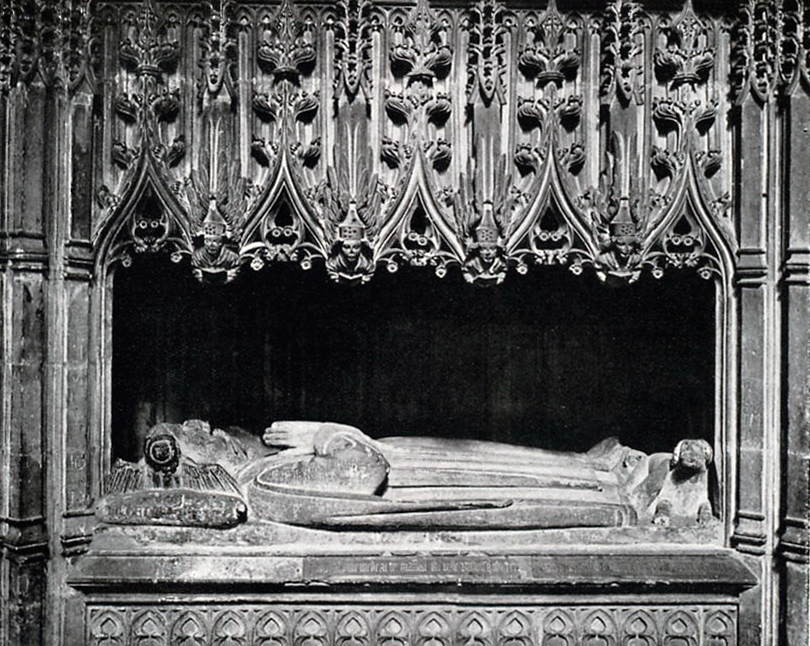 |
|
| St John the Baptist |
| Tower Lane |
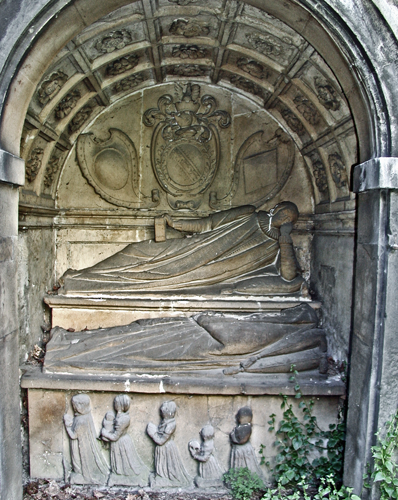 |
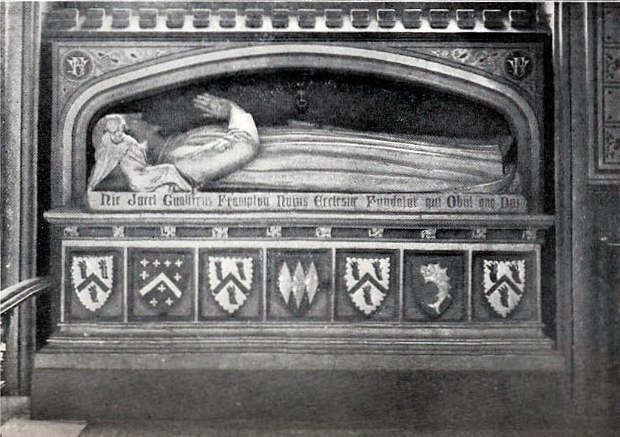 |
| Left:
Hugh Browne (1653) and
his wife: recumbent effigies on
a two tier tomb on the front of
which are kneeling figures of their son and four
daughters. This monument is in the church yard (Taylor's
Court) Above: Walter Frampton (1388) |
| Other Monuments |
The following are in the crypt: A Merchant (c 1510) and Two Wives. Incised slab on a tomb chest A Merchant (c 1550) and his Wife alabaster effigies on a tomb chest The following is in the body of the church: Thomas Rowley (1478) and his Wife brasses 1' 10" Andrew Innes (1723) Tablet with 2 flanking colums and angels' head. Signed by Rysbrack. |
| St Stephen |
| St Stephen's Avenue |
|
|
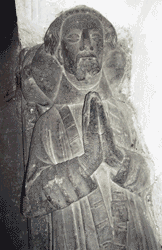  Walter Tyddesley (or Tididstille) (1385) He was MP for the city the year of his death. |
||||||||||
Also - Robert Kitchen (1594) Brass plate with kneeling figures in stone frame.
There are also many late 18th and early 19th C tablets in the church.
With thanks to Joan & Robert Tucker for providing new photogarphs of Edmund & Margaret Blanket.
The original were taken fron a book of the 1920's so welcomed improvement
|
|
|
|
||||||||||
|
|
1. St James's, Whitmore Street. Photographs Ó Julian Lee-Jones and used with permission. With thanks to the photographer and to Rob Harding for sending them to me
2. Several have also been provided by Phil Draper of Church Crawler . Thank Phil!
3. The older black and white photographs are from Archaelogia. Vol LXXIV, generously sent to me be the late Dr Claude Blair
4. The etchings are by T & G Hollis
I would most welcome and further photographs of monuments from Bristol churches, especiallyof those of which I do not have any, and any unsatisfactoy ones which were lost. Thanks!
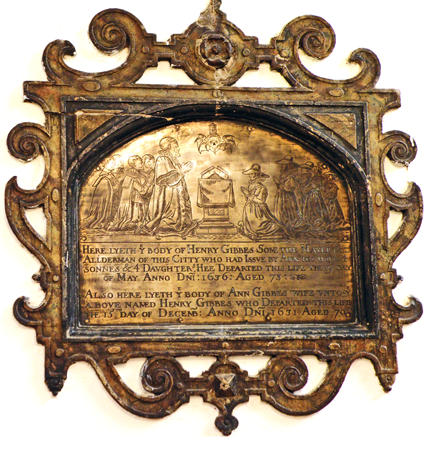
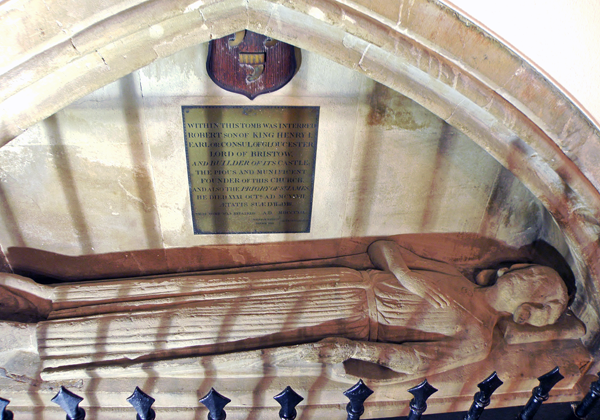
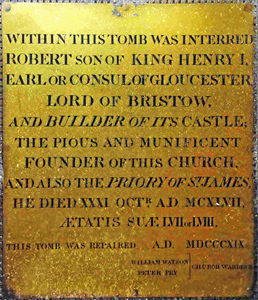
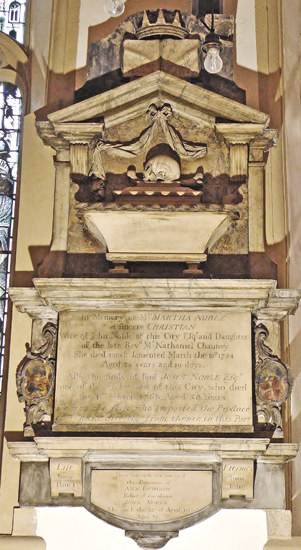
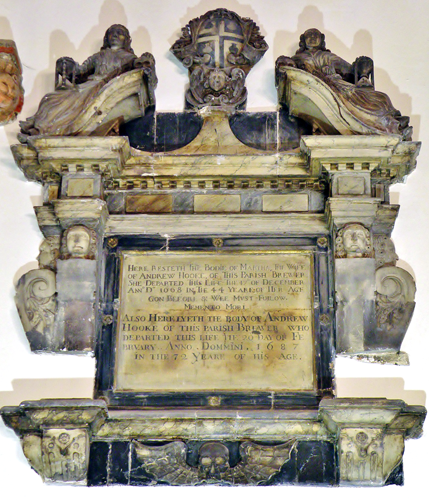
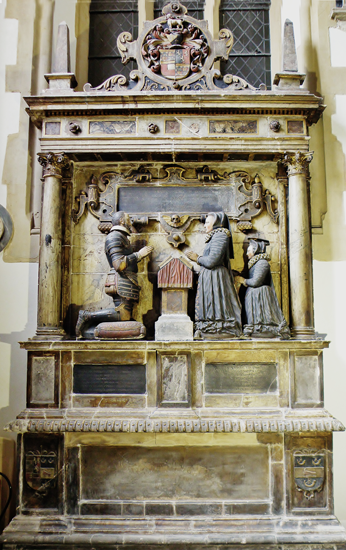

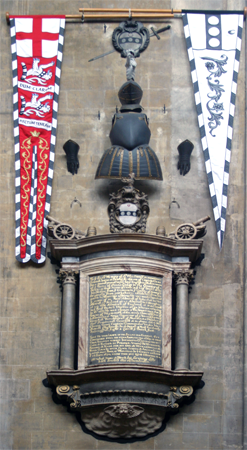
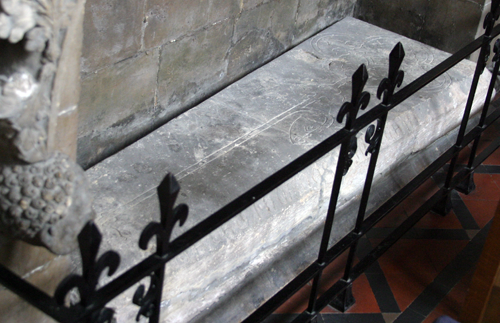
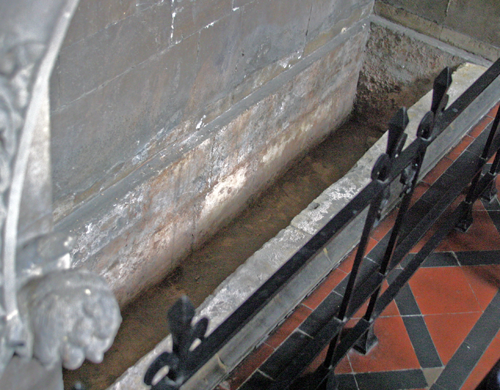
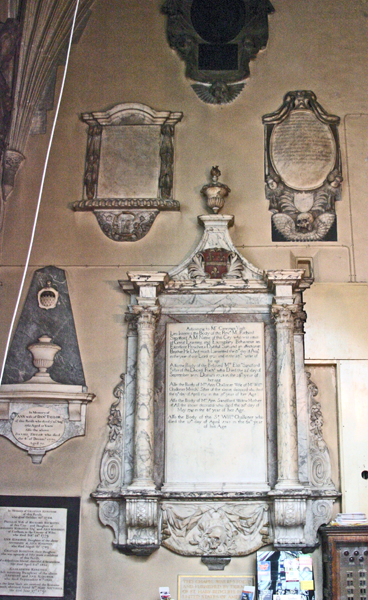
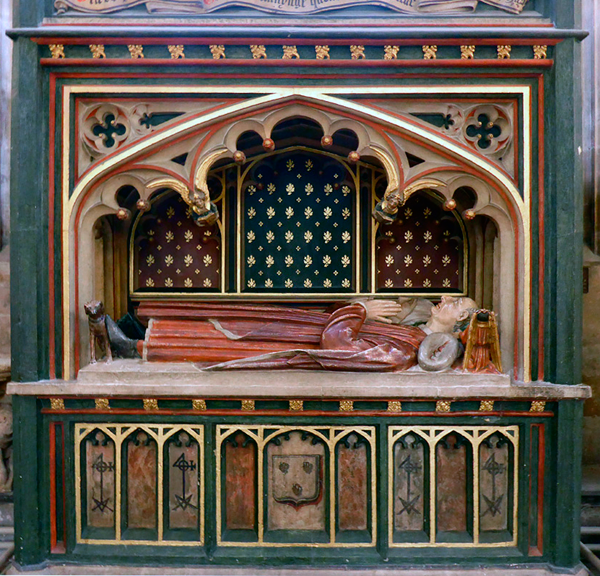
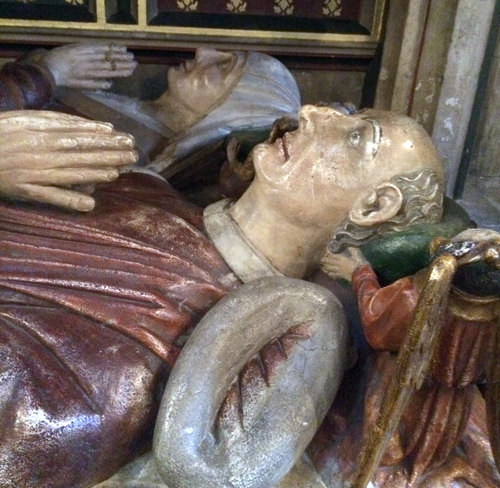
.png)
-(1).png)
.png)
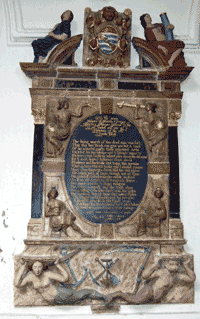


.png)
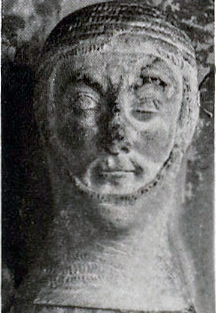
.png)
